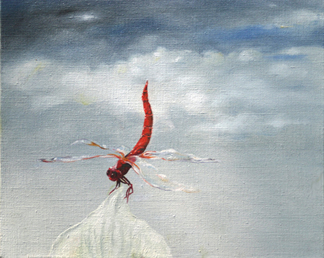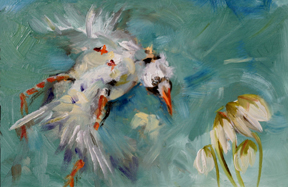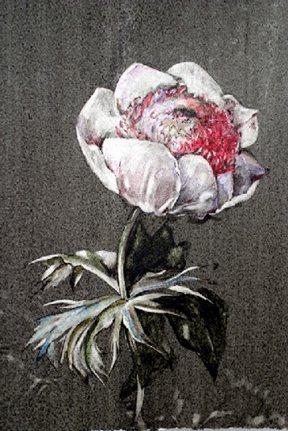Doris
Downes
at Ward Pound Ridge Reservation
 Dragonfly on Slipper Petal Oil on linen |
By
RAYMOND J. STEINER
ART TIMES July August
2008
HISTORY
HAS NOT been kind to female botanical artists — as if either the
subject or the gender of the artist was beneath “serious” consideration
for the self-acclaimed pundits of art — and we have made ourselves
culturally poorer for the deliberate and persistent oversight. A few years
back — in our March 2007 Issue — I addressed this problem
in a review of an exhibit entitled “Drawn and Colored by a Lady: Four
Centuries of Female Artists” featuring the work of “Lady” botanical artists at Arader Galleries
in New York City. I raised the question then, and I repeat it now —
why the gender bias when male botanical
artists such as Pierre Joseph Redouté (to name but the most obvious example)
became known worldwide as a court painter? As the title of the show at
Arader Galleries indicated, the only recognition women botanical painters
garnered was the almost grudging “drawn and colored by a lady” affixed
to such work when not done by male hands.
 Broken Angel, Oil on panel |
With the
current exhibition* at the Ward Pound Ridge Reservation in Cross River,
New York, I once again have the occasion — and pleasure —
to “beat the drum” in the name of “Lady” botanical artists — in
this case, of Doris Downes and her tastefully hung exhibition, “Eden (!)
Naturally”, in The Gallery in the Park. Some thirty-eight paintings
(oils, watercolors, and gouaches) and eight small bronze and paper sculptures
make up the show, and for anyone captivated by the beauty of nature, this
is one show you ought not miss — for both the work on view and its
venue in this lovely Westchester Park is sure to delight.
 Jack in Pulpit w/c |
True to
her calling of being a botanical painter, Doris Downes has a keen eye
and sure hand, necessities for anyone attempting to replicate nature with
any verisimilitude. Unlike the landscape painter who has long adopted
the right — even the mandate — to ‘improvise’, to imprint
his or her own vision on nature’s forms, the botanical painter must needs
bury such urges to ‘invent’ in order to earn the right to properly represent
her. No greater challenge, then, than to put forth in two dimensions the
intricacies of a three-dimensional flower without fudging the job. Downes
is most successful in accomplishing this feat when she turns her hand
to watercolor (there are fourteen in the show), her works on paper almost
always graceful, at times gorgeous (see e.g. “Paphiopedilum Xiang Tong),
and, at other times, dramatically forceful (“Toxic Garden”). To this viewer,
watercolor is by far her strongest medium, the technique most successful
in showing her sensitivity to her subjects. As any experienced watercolorist
knows, it is no easy task to make the medium “behave” and it takes years
of practice in hand/eye coordination to make it work — Downes obviously
has had such experience.
 Pink Peony, Watercolor on Paper |
This is
not to say that her oils (on linen, canvas and panel) deserve short shrift.
“Coming Home” (reproduced on the invitation), “Broken Angel”, “Flora and
Fauna”, “The Pollinator” and “Chillin” for instance, are of the highest
quality but, generally speaking, I came away with a preference for her
smaller works in oil, tight in composition and delicate in the use of
color. It is my belief that her strong background in composition holds
her in good stead here, offering the eye lingering images long after leaving
the gallery (“Dragonfly on Slipper Petal”, for example), while such paintings
as “Hudson Valley Wall” and “Landscape 1” with their attempt at spontaneity
through the use of loose brushstrokes and undefined outlines, less memorable.
Her treatment of skies — realistically lovely in “The Pollinator”,
surreal in “Can You See This” — are usually exceptionally handled,
and one suspects that Downes spends a good deal of time en plein air
intently studying
her subjects. Downes’ oils are also more vibrant, colorfully seductive
(though often lost in the larger paintings, which tend to dissipate visual
impact) than her watercolors, which are muted — and rightfully so,
since the seduction of color can often lead the eye away from detail and
precision, prerequisites in botanical representations.
Although
cleverly realized (Downes gives credit to Mike Lupa and Dave Weinstein
for casting and patina respectively), her eight “bird” sculptures left
me largely indifferent, their folded, paper wing-construction affixed
to bronze bodies reminiscent of those I’ve come across in Czech (Prague)
craft shops — “cute” but aesthetically bland. Undoubtedly their
inclusion makes “sense” in this particular venue of parkland, but they
are hardly on a par with her botanical masterworks.
 Paphiopedilum Xiang Tong Watercolor on paper |
Viewing
“EDEN(!) Naturally” is a
perfect opportunity to see both an exceptionally beautiful exhibition
and to visit one of Westchester County Parks Department’s prime “Art in
Parks” locations. Well-known to landscape artists for its varied landscape
opportunities —a group of painters met on-site and painted at Ward
pound Ridge a few days after I visited Downes’ exhibition — the
Reservation served as the setting for the movie “Pollack” made some years
ago about Jackson P{ollock’s ‘Springs’. In addition to The Gallery in
the Park, another gallery, The W.P.A. Gallery, is located a short distance
away and presently features the work of Dyan Rosenberg (thru Jul 27)).
*EDEN(!) Naturally: An Exhibition of Paintings & Small Sculptures by Doris Downes (thru Sep 7): The Gallery in the Park, Ward Pound Ridge Reservation, Cross River, NY (914) 864-7317
